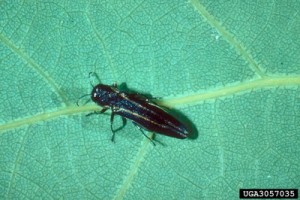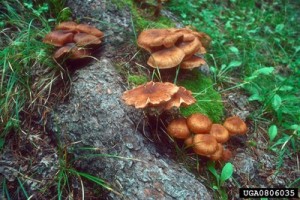Written by D.J. Moorehead and G.K. Douce for Forest Encyclopedia Network
Causal Agents
Oak decline is the name given to a slow-acting disease complex stemming from interactions between biotic and abiotic stressors of oaks (Quercus spp.). Abiotic factors that contribute to oak decline include tree maturity, low site productivity, drought, and spring frost. Biotic factors include root diseases such as Armillaria root disease (Fig. 1) (Armillaria spp.), canker causing fungi such as Hypoxylon canker (Fig. 2) (Hypoxylon spp.), defoliating insects such as gypsy moth (Fig. 3) (Lymantria dispar), and boring insects such as the two-lined chestnut borer (Fig. 4) (Agrilus bilineatus) (Wargo et al. 1983).
A few of the biotic agents associated with oak decline. Figure 1 (top left) Damage from boring insects, such as the two-lined chestnut borer, contribute to oak decline. Figure 2 (top right) Armillaria root diseases, such as Armillaria mellea, also further weaken oak trees. Figure 3 (bottom left) Hypoxylon canker is also associated with oak decline. Figure 4 (bottom right) Defoliation by gypsy moth caterpillars increases the susceptibility of oaks to the disease complex, oak decline. All photos courtesy of forestryimages.org.
Hosts
Oak species differ in susceptibility to oak decline. Species in the red oak group are more susceptible than the white oaks. Within the red oak group, black oak (Fig. 5) (Q. velutina) and scarlet oak (Q. coccinea) had been impacted most severely along with northern red oak (Q. rubra) and pin oak (Q. paulstris) (Wargo et al. 1983). White oak (Q. alba) and chestnut oak (Q. prinus) have been most affected in the white oak group. Other species reported to have had some effects from decline include ash (Fraxinus spp.), hickory (Carya spp.), birch (Betula spp.), beech (Fagus grandifolia), and maple (Acer spp.) (Wargo et al. 1983).
History
Symptoms of oak decline have been described in the eastern United States since the late 1800s (Oak 1994). Oak decline has become more prevalent since the 1950s, likely because of the shift in dominance to oaks during the early 1900s and severe droughts during the 1950s (SAMAB 1996). Another increase in the incidence and severity occurred in the early 1980s. Oak decline has been reported throughout the entire range of the oak dominated eastern hardwood forest. Within the southern Appalachians oak decline has been more prevalent on public lands than in private lands. North Carolina and Virginia have had the highest incidences of oak decline within the southern Appalachians (SAMAB 1996).
Symptoms
Oak decline leads to a reduction of radial growth and dieback of the canopy, leading to tree mortality. Older, mature trees are most likely to be affected by oak decline. The most easily recognized symptom of oak decline is the progressive dieback of the tree crowns starting from the outside of the crown and working inward. As the disease progresses, larger branches are killed. Branches having various states of decay, indicate death over time instead of in one event, help diagnose this disease (Oak 1994). Other symptoms may include:
- Chlorotic, dwarfed, or sparse foliage
- Epicormic growth (sprouting from the main stem and large branches)
- Premature autumn coloration
- Foliage death
Areas with new infestations of gypsy moth will show some of the most severe impacts due to oak decline. The defoliation caused by gypsy moth caterpillar feeding greatly increases tree susceptibility to oak decline.
Impacts
Oak will not be eliminated from the southern Appalachians due to oak decline but they will decrease in numbers and overstory dominance. Oak decline is a natural part of the ecosystem and positive and negative impacts will result from oak decline occurrences (SAMAB 1996).
- Positive benefits include:
- Higher overstory richness and evenness
- Increase in cavity nesting and den sites
- Creation of small openings
- Stimulation of understory species
- Increase in coarse woody debris
- Negative impacts include:
- Reduction in oak regeneration
- Lower harvest volumes
- Increased fire hazard
- Smaller mast crops (decrease in wildlife food)
Adapted for eXtension.org by Tom DeGomez, University of Arizona
References Cited
Oak, S.W. 1994. Oak Decline. In: C. Ferguson and P. Bowman , eds. Threats to Forest Health in the Southern Appalachians. Southern Man and the Biosphere Cooperative: 36.
SAMAB (Southern Appalachian Man and the Biosphere). 1996. The southern Appalachian assessment terrestrial technical report. Atlanta: U.S. Department of Agriculture, Forest Service, Southern Region.
Wargo, P.M., D.R. Houston, and L.A. LaMadeleine. 1983. Oak Decline. USDA – Forest Service. FIDL-165. 7 p.
Related to Oak Decline:
- Microflora and Fauna in Forests
- Climate Change Impacts on Forest Diseases
- Invasive Diseases
- Invasive Species and Climate
- Invasive Species and Biodiversity





